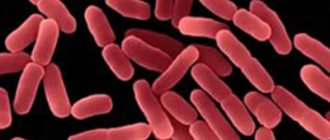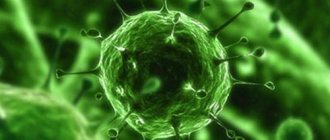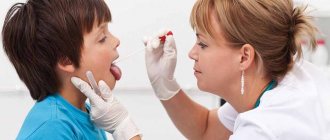Coxsackie virus photo
Annually recurring seasonal epidemics of acute respiratory diseases do not cause particular concern. It’s another matter if you have to deal with viruses that are rarer in our latitudes. The Coxsackie virus is an enterovirus that lives in hot climates, but also thrives in cold regions. Disease epidemics associated with it may be associated with travel abroad. The symptoms of the Coxsackie virus can easily be confused with regular flu, chickenpox and other diseases, so it is important to know the specifics of its effect on the body.
Diagnostics
Diagnosis is based on the presence of typical clinical manifestations (angina, neonatal encephalomyocarditis, epidemic myalgia, etc.). In this case, seasonality (summer-autumn period) and the epidemic situation in the region are important. During the collection of complaints and medical history, attention is paid to possible contacts of the patient with carriers of the infection. Additional studies are prescribed depending on the damage to certain organs and tissues by the virus.
The easiest way to diagnose the Coxsackie virus is to identify antibodies to it
Direct isolation of an infectious agent from biological fluids (blood, feces, cerebrospinal fluid, nasopharyngeal fluid, tear fluid) of a sick person is possible, but is rarely done in clinical practice. Another method is more often used - the detection of antibodies to the virus, for which they use the complement fixation reaction and the hemagglutination inhibition reaction. The diagnostic criterion is an increase in antibody titer by four or more times. In addition, the infectious agent can be determined in the patient's stool and nasopharyngeal swabs using polymerase chain reaction, which also makes it possible to determine the genotype of the virus.
The Coxsackie virus is diagnosed in adults much less frequently than in children; children under 5 years of age are most susceptible to it.
What is Coxsackie virus
The virus got its name in honor of the city of the same name, which is located in New York state and where it was first studied back in the late forties. It belongs to the group of enteroviruses, but differs from many others in its specific manifestations and complications. The Coxsackie virus manifests itself especially severely in children due to underdeveloped immunity.
Like other enteroviruses, it is activated in warm weather, although it easily tolerates a decrease in temperature. There are a huge number of strains, so after a single illness, long-term immunity does not form. All subspecies are conditionally divided into two groups - A (CVA) and B (CVB).
It is believed that strain A is more dangerous because it leads to the following complications:
- herpetic sore throat;
- stomatitis;
- pleurisy and viral pneumonia;
- muscle paralysis;
- meningitis.
Studies have found that severe consequences develop in 80% of cases. Laboratory mice that were infected with subtype A died from meningitis, muscle paralysis, and severe pneumonia. Pregnant females experienced miscarriages.
Type B was characterized by a lower percentage of complications; up to 60% of laboratory rodents survived infection without consequences. However, in cases where additional symptoms developed, the following secondary diseases appeared:
- pericardial effusion - congestive heart failure with cardiac edema;
- myocarditis;
- hepatitis;
- pericarditis;
- pancreatitis.
Coxsackievirus can develop in any of these types, although in most cases there are no serious consequences in people. Normally, the disease manifests itself at the level of a “regular” intestinal flu, plus specific symptoms characteristic of this particular pathogenic microorganism. Some doctors believe that the transferred Coxsackie virus in children affects the development of diabetes mellitus in adulthood, but this assumption still remains at the level of a medical hypothesis.
The greatest spread of the Coxsackie virus is observed in warm countries. It appears on the territory of our country as a result of vacations and travel. For example, there have been many cases of the disease brought from Turkey, where this virus is endemic.
Doctors do not consider the Coxsackie virus to be too dangerous, and it is pointless to vaccinate against it due to the fact that new mutations of the main strains constantly arise. Children under five years of age and adults with weakened immune systems are at risk for the disease, however, with a large accumulation of the infectious agent, epidemic situations similar to influenza or ARVI in the autumn-spring period are possible.
Possible complications
If a woman becomes infected with the virus during pregnancy, there is a high risk that she will infect the child. But for children under 4-6 months the disease does not pose any threat, because The baby will still have antibodies in the blood that were received during pregnancy via the placental method from the mother. Antibodies penetrate into the baby’s body through breast milk.
The virus, if there are other diseases and severe pathologies in the body, can provoke a number of complications:
- With a weakened immune system and the addition of infectious diseases, heart complications may occur. Coxsackie may cause endocarditis, pericarditis, or myocarditis.
- The disease can provoke the development of serous type meningitis.
- The virus can cause the development of pleurodynia, a pathological condition of the muscles when a large amount of pathogenic microflora accumulates in them. The pathology manifests itself as severe muscle pain, which intensifies when walking, and difficulty breathing.
Coxsackie virus does not always have severe consequences; complications are associated with the presence of predisposing factors. Hepatitis as a complication due to the development of a virus occurs in cases where the patient previously had problems with this organ, for example, a person had hepatitis. Dehydration of the body often develops against the background of Coxsackie. The pathological condition is associated with the lack of adequate treatment.
Causes and methods of transmission
Among childhood infections, the Coxsackie virus occupies a special place due to its extreme contagiousness. Its contagiousness reaches 98%, which is five to ten times higher than most other enteroviruses - that is, those species that develop in the human intestine. The incidence is seasonal both in those countries where it is endemic and in our country, where it is “brought” by vacationers abroad.
The virus is resistant to the environment; freezing does not affect it. It can survive in soil or water for up to two years. It is destroyed by direct sunlight, boiling for at least 20 minutes, and exposure to chlorine-based disinfectants. Many people are accustomed to disinfecting suspicious objects and surfaces with alcohol or vodka, but in this case, ethanol-containing liquids are ineffective.
Despite the fact that, in its origin and structure, the Coxsackie virus is the closest “relative” of polio and is transmitted in a similar way, it rarely causes severe consequences.
However, you should beware of the same sources of infection:
- Dirty hands are the first way to “catch” the Coxsackie virus. Ordinary soap and hygiene products do not cause any harm to the strains.
- Poor quality food. The virus can survive for a long time in meat, vegetables, fruits and other food if it was prepared by an infected person. Boiling helps destroy the source of the disease.
- Household items - towels, toothbrushes. Since this childhood infection is an intestinal virus, there is a high risk of transmission in dirty bathrooms, especially if there are both a toilet and toothbrushes in one small area. This arrangement of plumbing fixtures is typical for mid-price hotels, which is an additional risk factor when traveling.
- Bed linen and clothing. The virus remains active on fabric even after normal use; it can only be killed by adding additional disinfectants or boiling.
- Direct contact with the sick person. Infection occurs when you are in the same room with an infected person with a probability of up to 98% percent. Five to ten minutes or any close contact is enough - a handshake, hugs, kisses. At the same time, in adults, the disease can occur in a mild, aborted form, and the person will not even know that he is dangerous to the child.
- Sharing utensils is another cause of epidemics in hotels where these common items are not washed well enough. A single sick person can spread the virus to an entire hotel, kindergarten, camp and any space where the same utensils are used by different people.
Airborne transmission of the Coxsackie virus in children is relatively rare, although doctors believe that this is one of the causes of epidemics in schools, kindergartens or camps. The basic one remains fecal-oral, however, compared to other infectious agents, strains of this virus are more survivable and have an extremely high ability to infect the human body.
The Coxsackie virus constantly circulates in the population, since a person who has recovered from the disease remains a carrier of the infection for two to three months after the disappearance of symptoms. In view of all these factors, disease prevention becomes quite a difficult task. It is considered an “exotic” infection, but cases of the disease occur every year, and doctors are well able to identify the virus by its characteristic clinical picture.
Prevention
To protect the body from the pathogenic virus, it is enough to follow simple preventive measures. Before eating, it is necessary to thoroughly wash vegetables and fruits, especially those bought by hand or in stores.
Personal hygiene plays a significant role in preventing the virus. It is not recommended to swim in public pools for people with a weak immune system, when the body cannot resist even a slight concentration of pathogenic microflora.
Prevention for young children consists of increasing the protective functions of the immune system and instilling in children a culture of hygiene.
It is not recommended to share the same household items with strangers: towels, toothbrushes, kitchen utensils.
Symptoms
Most enteroviruses provoke diarrhea and vomiting - this is a basic characteristic symptom that comes from the location of the microorganisms, their method of reproduction and nutrition. The Coxsackie virus is an exception: it does not always provoke diarrhea, but is characterized by a specific symptom complex. Its manifestations may differ depending on type A or B, this should also be taken into account.
There are common symptoms of the Coxsackie virus:
- Heat. What distinguishes this disease from “ordinary” diseases - ARVI, influenza - is that it is very difficult to bring down a fever. Traditional remedies do not work, and the temperature can reach critical levels - forty degrees and even higher.
- Headache - it has a characteristic pressing character; if a very small child is sick, he will cry constantly.
- Aches and muscle soreness, which is much more intense than during the flu, since the Coxsackie virus is a “relative” of polio, although not as malignant.
- General weakness, loss of appetite, rarely - nausea.
- Children often experience constipation, which distinguishes Coxsackie from other enteroviruses that provoke the opposite symptoms.
- On the second or third day, characteristic rashes appear on the legs and arms. This rash is similar to rubella or chickenpox, leading some doctors to misdiagnose it.
Further, manifestations may differ depending on the type of virus and those organs in which the pathological process develops most intensively. Type A is characterized by a clinical picture with intense involvement of the skin and mucous membranes.
Therefore, symptoms include:
- Herpetic sore throat - this complication almost always occurs in children. The mucous membranes are affected by characteristic rashes that are extremely painful.
- Conjunctivitis with photophobia, severe lacrimation. The eyes are red.
- Stomatitis is painful sores in the mouth, most often on the gums and tongue.
- Skin manifestations are very pronounced - up to the appearance of large blisters filled with serous exudate.
- Paralysis that develops at lightning speed and passes just as quickly when cured. However, there is a risk of paralysis of the respiratory system, as well as serous meningitis as a complication.
These manifestations develop rapidly and pass just as quickly. Type B virus is characterized by a longer course and the following specific clinical picture:
- Nausea, vomiting.
- Sometimes, after one or two days of constipation, diarrhea may occur, with stool that is dark brown in color and foul-smelling.
- Abdominal pain, which feels more like a “general” pain, because the virus affects not only the intestines, but also other organs of the abdominal cavity.
- If the liver is damaged, this organ becomes enlarged, heaviness in the right side, and the mucous membranes may become jaundiced.
- Shortness of breath and drowsiness - indicates a malignant course of the disease with the development of complications in the heart.
As with other viral diseases, Coxsackie manifests itself abruptly, with symptoms increasing over several hours. Normally, all manifestations pass just as quickly, the disease does not last more than three to seven days. Longer manifestations indicate a severe course of the disease, and may also indicate the addition of a bacterial infection.
Methods of infection and signs of disease
The disease is contagious (from the Latin “contagiosus” - contagious) due to the fact that the virus enters the human body both by airborne droplets and through unwashed hands, as well as through contaminated water and products (alimentary route). In rare cases, a transplacental route of penetration of the virus (from mother to fetus) is noted. But this is the exception rather than the rule. You can become infected from a patient in the manifest (clinical form with a full set of symptoms characteristic of the disease) and inapparent form, as well as from a carrier of the virus.
Symptoms of the Coxsackie virus in a child manifest themselves in the appearance of a characteristic itchy rash
The incubation interval lasts several days, and then the patient’s temperature rises sharply (up to 39-40°C). For a disease caused by the Coxsackie virus, the symptoms in children and adult patients are almost identical:
- dyspepsia, nausea, vomiting or diarrhea;
- elevated body temperature, which is difficult to correct with medication;
- aches and pain in the joints;
- increased fatigue and cephalalgia;
- weakness;
- discomfort in the throat.
These signs do not distinguish the described disease from other enteroviruses. Typical syndromes for this disease are vesicular pharyngitis, Boston exanthema (HFMD), myalgia and aseptic meningitis.
Infectious exanthema
With infectious (Boston) exanthema, typical rashes appear on the hands and feet (less often the thighs) - small red bubbles (vesicles) with transparent contents (what the Coxsackie virus looks like in children, the photo symptoms demonstrate clearly and clearly). In children and adults, the rash is accompanied by itching and burning.
In some cases, the Coxsackie Virus in elderly elderly patients causes complaints not of itching, but of severe pain in the affected limbs, most often in the fingers. The rash goes away without a trace within a week. Moreover, on the first day the disease is confused with measles and scarlet fever, on days 2-3 - with chickenpox. On the 4th day of illness, the rashes turn pale, burst, and the skin peels off.
Along with skin rashes, aphthous ulcerations are found in the patient’s mouth, making the mucous membrane sensitive to cold and hot foods. “Aphthae” is the definition of painful ulcerations (ulcers), 3-5mm in size and having a round or oval shape. Canker sores appear on the gums, inside the cheeks and on the roof of the mouth. The photo gives a clear idea of what the symptoms of the Coxsackie virus look like. This form is also quite specific.
Signs of infection in children
After infection with the Coxsackie virus, symptoms in young children will include such manifestations as moodiness, hypersalivation and irritability, loss of appetite and discomfort and pain during eating.
Coxsackie virus in children (photo) symptoms and manifestation of enteroviral eczema on the skin of the hands
How the mucous lining of the oral cavity reacts to the introduction of the Coxsackie virus in children - the photo will easily demonstrate. From the same images, you can understand that, unlike herpangina, with HFMD the tonsils remain clean. But in the case of the development of angina, a typical picture for this disease is observed:
- swelling of the tonsils;
- pain when swallowing;
- cough;
- acute rhinitis;
- sharply painful erosions on the oral mucosa;
- inflammation of regional lymph nodes.
In its atypical form, this disease can take the form of the so-called summer flu, catarrhal inflammation of the upper respiratory tract, encephalomyelitis of newborns, inflammation of the conjunctiva in a hemorrhagic form, etc.
With summer flu, the symptoms are indistinguishable from influenza manifestations in the fall, however, small children become infected during the beach period.
In addition to asking what are the symptoms of Coxsackie in children (photos of pathological changes), parents are naturally also interested in the question of how to treat this disease.
Watch Dr. Komarovsky's program, which talks about enteroviruses and their varieties, with a special emphasis on herpangina polio and the coxsackie virus, also called “hand-foot-mouth syndrome.”
Coxsackievirus in children
The disease is considered “childhood”. Most often, the Coxsackie virus affects babies from three to five months to five years; infants get sick less often due to maternal immunity received from milk, but those who eat substitutes are at risk.
Sometimes doctors mistake coxacovirus infection for chickenpox due to the characteristic rashes. Specificity will help to distinguish: with Coxsackie, the feet are always affected, so the child may complain of pain when walking, while the skin manifestations of chickenpox are distributed less specifically.
The following measures are applied to sick children:
- If the course of the disease is favorable, no specific treatment is required. Measures should be aimed only at getting rid of unpleasant symptoms.
- Antipyretics must be used. It is worth remembering that they act worse than with regular flu. You cannot increase the dose on your own; if you cannot bring down the temperature, you should consult a doctor.
- The rashes in the mouth, arms and legs are very painful. To alleviate the condition, it is necessary to use local antiseptics. It is recommended to limit solid foods so as not to injure the throat and oral cavity. The child is fed purees and cereals.
- Drinking plenty of warm fluids is one of the best ways to effectively help the deist body cope with the Coxsackie virus. You can use teas, if you are not allergic, with the addition of citrus fruits.
- The use of sorbents is recommended - activated carbon, Enterosgel. This helps remove the intestinal virus from places where it accumulates.
Coxsackie virus in children
Adults should provide the child with bed rest and maximum rest. The room in which the sick baby is located should be dim, well ventilated, and at room temperature.
You should closely monitor for the appearance of dangerous symptoms, such as:
- stiffness of the muscles of the neck and back of the head - indicates the development of meningitis;
- paralysis;
- labored breathing;
- repeated painful vomiting - it indicates a severe hepatitis form;
- dyspnea;
- a decrease in blood pressure is a signal of the disease transitioning to myocarditis.
Doctors believe that a child is normally quite capable of contracting the Coxsackie virus disease on an outpatient basis. Inpatient intervention may be necessary only if complications occur.
How does the virus progress?
The latent period on average does not exceed ten days. At this time, the child is already considered contagious, although there may be no signs. The virus manifests itself within 24 hours in an acute form. In the morning, the baby is alert and active, and by the evening the thermometer will rise to 38-39 degrees. Children in their first year of life need to be especially closely monitored.
The baby becomes capricious, lethargic, drowsy, and nasal congestion appears.
For problems with the gastrointestinal tract, classic symptoms may be supplemented by severe vomiting, diarrhea, and bloating .
All these are general signs characteristic of any infection caused by enteroviruses.
Specific signs of Coxsackie include:
- rash in the form of small vesicles , spreading to the mucous membranes, areas around the mouth, palms and soles;
- pain in the throat , accompanied by discomfort during swallowing, wheezing and a dry, pressing cough;
- swollen lymph nodes.
When these two signs are combined simultaneously, pediatricians diagnose a disease associated with the Coxsackie virus.
To date, 2 subtypes of the Coxsackie virus have been studied: type A and B. The latter carries a real danger, it affects the brain and provokes changes in the cardiac muscle tissues.
It is quite rare for Coxsackie to behave like polio :
- the child’s motor activity is impaired, up to minimal paralysis of the legs,
- The baby may suddenly begin to limp.
The appearance of signs characteristic of meningitis indicates that pathogenic organisms are actively “working” in the brain . All these signs are characteristic of a severe form of the disease.
Coxsackievirus in adults
Adults get sick with Coxsackie less often and tolerate the disease much easier. However, the development of complications may be caused by a nonspecific reaction of the immune system, especially if it was previously compromised or weakened by other diseases.
Symptoms in adults are usually mild:
- temperature rise to 38.5 - 39 degrees;
- headache;
- general weakness;
- diarrhea;
- rashes do not always appear.
The disease in adults lasts two to three days, after which it passes without a trace, but the person remains a carrier of the infection and poses a danger to others, especially children. Therefore, bed rest and avoiding contact with healthy people are important. It is precisely because of the extremely high contagiousness that it is undesirable for adults to endure the disease “on their feet.”
Forms
There are several forms of the disease: the intensity of the syndromes, the duration of the disease and the degree of damage to the body systems are affected.
The following forms are distinguished:
The disease can occur in waves, with relapses and complications. The first form is considered the easiest: recovery occurs on the 10th day with complete disappearance of symptoms.
Further classification involves division according to the predominant syndrome :
- Herpetic sore throat . The tonsils become inflamed, ulcers appear on their surface, which spread to the soft palate and the back wall of the pharynx.
- Myalgia of an epidemiological nature . The child complains of muscle pain. This type of Coxsackie virus syndrome is rare.
- Pathologies of the central nervous system caused by ischemia of areas of the brain. First of all, this is serous meningitis, then poliomyelitis. The syndrome can be suspected based on characteristic signs: high fever, vomiting that is not associated with food, the appearance of convulsions, impaired consciousness, a specific arched body position, photophobia.
- Enteroviral fever . Pathology, the main symptom of which is high temperature, the general unsatisfactory condition of the child.
- Myocarditis, pericarditis . The condition is dangerous due to complications such as heart failure. Manifested by severe fever, pain in the heart, cyanosis of the triangle around the nose and mouth, shortness of breath. The cardiogram clearly shows serious changes.
- Upper respiratory tract problems . One of the simplest forms of pathology. The patient stabilizes after a few days. In addition to the fever, there is a sore throat, dry cough, runny nose, and nasal congestion.
- Hemorrhagic conjunctivitis . Painful sensations in the eyes, swelling of the eyelids, abnormal tearing, redness of the eyes are diagnosed - this is an incomplete list of the main symptoms.
- Hand-foot-mouth syndrome is characterized by a specific ulcerative rash. Detachment of nails and changes in skin are observed. May continue for a long period of time.
How to treat
There is no specific treatment. In the vast majority of children and adults, the disease goes away on its own within two to seven days, without requiring any measures other than those aimed at general improvement and detoxification of the body.
For more severe disease, the following medications can be used:
- Interferons - for general antiviral action.
- Antipyretics should contain ibuprofen or paracetamol. Aspirin is contraindicated.
- It is imperative to replenish fluid loss; if there is not enough drinking and dehydration is detected, infusion therapy is carried out.
- The use of sorbents is recommended for any course of the disease; they help remove the virus from the body.
- External remedies are used against ulcers to relieve pain and itching.
- General strengthening agents - vitamins, micronutrients - will help cure the Coxsackie virus.
Antibiotics for the Coxsackie virus are used only in the case of a secondary bacterial infection. Self-prescription of potent drugs is unacceptable. If severe complications develop, damage to the central nervous system or cardiovascular system, hospital treatment is necessary.
Treatment of a viral infection
The well-known saying: “Treat a runny nose and you will recover in just 7 days, do not treat it and then you will have to be sick for a whole week” - clearly describes the possibilities of treating this disease. If you have Coxsackie, how to treat the disease is better to consult with your doctor. The main treatment strategy is to ensure bed rest and the following supportive therapy measures:
- plenty of warm drinks;
- a gentle diet that allows minimal trauma to the affected mucous membrane;
- vitamins.
After the Coxsackie virus is diagnosed in children, treatment is most often carried out at home, hospitalization is required only in severe cases (meningitis, pericarditis, etc.). There is no specific therapy for this disease.
In the first 1-3 days with Coxsackie, treatment for weakened children and young patients with severe disease is prescribed using the antiviral agent Gamma globulin, which contains antibodies to the virus and Ribonuclease, which can partially deactivate the RNA of the virus. Please note that according to representatives of official medicine, Acyclovir and its analogues, which are effective in treating herpes virus infection, are not effective against Coxsackie.
With the Coxsackie virus, symptoms in children can manifest themselves in the form of herpetic sore throat
However, according to reviews of mothers vacationing with children in Turkey and having experience in treating coxsackie with local doctors, you can often find information that a Turkish doctor prescribed Acyclovir syrup and ointment against allergic itching externally, and the disease subsided within 3 days. The information, as they say, is food for thought.
Medications
For an illness caused by the Coxsackie virus, treatment, or rather the main therapeutic part, is symptomatic therapy:
- Antihistamines orally or locally (Psilo-balm, Fenistil, Erius, Loratadine). These remedies help fight itching during exanthema and alleviate general symptoms of intoxication.
- NSAIDs (Ibuprofen, Panadol). Children should not be given medications containing Acetylsalicylic acid or Analgin.
- Sorbents (from activated carbon and Smecta to Enterosgel and Polysorb). These remedies help fight intoxication. They also help remove viruses and their metabolic products from the body.
- Rehydration agents. These remedies are good if the patient is noticeably dehydrated (with vomiting and diarrhea). Restoring electrolyte balance is especially important when treating young children. They are usually given orally. These are either saline solutions or glucose-saline solutions (Regidron, Reosolan, etc.).
- Local antiseptics for rinsing the mouth, relevant for aphthous stomatitis and herpetic sore throat (soda solution, chamomile decoction, Hexaolyse, Stomatidin and others).
- Antibiotics are prescribed individually if a bacterial infection is detected.
When considering the issue of medications for the treatment of the Coxsackie virus, one should not forget about immunomodulators and interferon preparations (Viferon, Polyoxidonium, Laferobion, Immunoflazid, etc.). This group of drugs needs to be connected to the therapeutic set from the first days of the disease to activate the immune response.
Preventive measures
Of course, it is extremely important for someone sick with Coxsackie to know how to treat the disease, but everyone knows that the best remedy for any disease is a strong immune system. Therefore, it makes sense to carry out preventive procedures to harden the body and eat a balanced, healthy diet. Briefly mentioning the aspect of strengthening the immune system, we will talk about almost the most effective dietary supplement that can be used to strengthen the immune system.
This drug is called Colostrum and is made from cow colostrum and has pronounced immunomodulatory properties with a complete absence of side effects, which is typical. We strongly recommend that you pay attention to this biological additive. Remember that it is much easier to prevent any disease than to treat its manifestations and consequences.
Nutrition
A proper diet helps the body cope with infection. In the case of Coxsackievirus, nutrition plays an additional role due to rashes in the throat or mouth that make eating difficult. Patients almost always experience a lack of appetite, so it is important to adhere to the optimal menu:
- Food should be high in calories, but easily digestible, without excess fat or carbohydrates.
- Dishes are prepared in crushed form to make it easier for the patient to eat them.
- Preference is given to soups, cereals, and purees. It is unacceptable to eat food that is too hot or cold.
- Spices, spices and other substances that irritate the mucous membranes are completely excluded.
- It is necessary to ensure the supply of vitamins and probiotics, so it is advisable to consume boiled or steamed fruits and vegetables, as well as fermented milk products.
Diet for the Coxsackie virus
The correct diet for the Coxsackie virus will help you quickly cope with the viral infection and return to normal. It is advisable to eat small portions several times a day, even if you have no appetite. If a child with Coxsackie completely refuses to eat, it is necessary to persuade him to at least drink warm liquid in large quantities. Normally, appetite returns within a day or two.
Etiology: causative agent of infection and causes of disease
The causative agent of Coxsackie is an enterovirus. In most cases, infection occurs through dishes, unwashed food, water and dirty hands. Because of this, the virus more often affects young children who do not adhere to hygiene rules. Another person or a virus carrier can also become the source of the pathology. Tourists are often at risk.
On the first day after infection, the virus concentrates in the mucous membrane of the nasopharynx. Next, reproduction begins, which occurs in the intestinal lumen. There, the necessary conditions are created for the virus to be transmitted through the fecal-oral route. Infection occurs as a result of consuming contaminated food and water.
The incubation period is 10 days. After this time, the patient’s pathology worsens. As a result, symptoms become more severe. The child develops a fever and a rash appears on the palms, soles and mouth.
Medications
To eliminate the main symptoms of pathological conditions resulting from the development of this virus, different drug treatment regimens may be recommended. In the absence of complications, therapy can be carried out at home. Since there are no etiotropic drugs, drugs that alleviate the symptoms of the disease are used. Typically, treatment regimens in these cases consist of:
- antipyretic drugs;
- anti-inflammatory drugs;
- analgesics;
- immunomodulating drugs;
- sorbents and antihistamines.
Antiseptics are used for local treatment of ulcerations on mucous and skin surfaces. In addition, it is necessary to maintain bed rest and drink more fluids. If the patient's condition worsens and any complications develop against the background of an enteroviral disease, an urgent need to consult a doctor.
The immune system in childhood is just developing. The child’s body is susceptible to many infectious diseases; one of the pathogens that can cause the disease is the Coxsackie virus.
The risk of becoming infected through contact with a sick person or a virus carrier is 98%.
Once in the body, the Coxsackie virus affects the digestive system (gall bladder , appendix , duodenum), nervous system, liver and other organs. The disease passes easily and ends in complete recovery, but in some cases serious complications are possible.
Symptoms of Coxsackievirus infection in adults
Signs of infection in adults may appear slightly different than in children. Their manifestations directly depend on what type of Coxsackie virus has entered the body. If we are talking about a group A virus, then the disease may be generally asymptomatic.
If the immune system is unable to cope with the infection, the first symptoms will be:
- short-term increase in temperature and accompanying chills;
- small maculopapular rash;
- areas of skin hyperemia.
Usually these manifestations disappear within 3-6 days, and the person feels healthy again.
Group B viruses are not easily tolerated by the body, and their reproduction and development in organs and tissues leads to the appearance of:
- muscle pain;
- rash and itching, including on the soles and palms;
- abdominal pain;
- painful wounds and rashes in the mouth;
- severe increase in temperature, feeling of chills, weakness, body aches;
- nausea, vomiting, diarrhea.
Hand foot mouth syndrome
In nature, there are many enteroviral infections that develop in the human gastrointestinal tract. They can cause pathological conditions accompanied by different symptoms. One such manifestation may be the common but underdiagnosed hand-foot-mouth syndrome. This term characterizes the appearance of specific skin rashes on the extremities, oral mucosa and around the lips. These signs are common in children. Such formations can be provoked by the Coxsackie virus, the photo of the rash in which is similar to the rash caused by chickenpox or rubella.
Hand-foot-mouth syndrome most often occurs when infected with a type A virus. There are also type B and type 71 (EV71) viruses. Each of these pathogenic agents is highly persistent in the environment and, under suitable conditions, remains viable for several months. Natural reservoirs for infectious agents are bodies of water, soil, some food products and the intestinal system of people and animals.
Treatment
In the absence of complications, treatment can take place at home. An etiotropic medicine (acting on the causative agent of the disease) has not yet been developed, therefore drugs that alleviate the patient’s condition are used (symptomatic therapy):
- antipyretics ( Ibuprofen, Paracetamol );
- anti-inflammatory drugs ( Acetylsalicylic acid (Aspirin) );
- analgesics ( Paracetamol );
- immunomodulatory ( Polyoxidonium, Sandoglobulin, Cycloferon );
- vitamins B1 and B2 to mobilize the immune system;
- sorbents ( Activated carbon, Enterosgel );
- local antiseptics for treating wounds on mucous membranes ( Furacilin, Hexoral ) and on the skin ( Fukortsin, Diamond Green );
- antihistamines for severe itching and allergic reactions ( Diphenhydramine );
- drink plenty of fluids to avoid dehydration;
- compliance with bed rest;
- Diet: light food, exclude sweets, fatty foods, spicy foods;
- microclimate: air temperature about 18-22oC, humidity 60-70%.
In case of complicated course, the following are used:
- glucocorticosteroids for damage to the central nervous system;
- diuretics for cerebral edema;
- in case of acute heart failure - Strophanthin, Korglikon ;
- antibiotics for complications of secondary bacterial infection.
Treatment at home should be accompanied by close monitoring of the patient, this is especially important when symptoms worsen in children. If the condition worsens, you must immediately call a doctor.
How to prevent infection
No one knows how dangerous infection with the Coxsackie virus is. It will be good if everything turns out to be a banal three-day fever. What if the disease is complicated by myocarditis or meningitis?
To date, no vaccine has been obtained for the Coxsackie virus, as well as for other enteroviruses. The only prevention is personal hygiene. But since the main route of transmission of the virus is still airborne, this method is not a panacea. It is advisable for the child to spend less time in crowded places, especially during the epidemic period.
Be careful about summer infections - they are not as harmless as they seem at first glance.
Important! The patient should be isolated from healthy children and adults. It is advisable that the isolation lasts about 1-1.5 weeks. It is advisable to administer 7-globulin to children in areas of infection.
Course of the disease
The Coxsackie virus is transmitted with almost 98% probability. When it enters the body, it attaches to the surface of mucosal epithelial cells (these can be cells of the digestive organs or respiratory tract). After some time, it penetrates inside the cell and integrates into its DNA. From this moment on, the cell ceases to perform its functions and reproduces new viruses.
The time between the introduction of the virus and its activation is called the incubation period . For the Coxsackie virus it ranges from 2 to 10 days. After the incubation period, an acute form of the disease occurs . Visible symptoms appear - fever, indigestion, rash on the palms of the feet, rashes inside the mouth.
Important: if the rash spreads to the mucous membrane of the throat, the child refuses to drink, and the infant refuses to eat milk (it hurts to swallow). This can cause dehydration, especially at high temperatures.
After a few days, the oral rash spreads to the skin of the face (appears around the mouth). The rash on the arms and legs bursts and turns into ulcers, around which the skin peels off. Skin peelings are localized around the nail plates and are a typical sign of hand-foot-mouth disease. After skin peeling, the nails will peel off. With Coxsackie, the virus on the nails allows you to diagnose the disease and distinguish it from other viral infections .
A new blistering rash appears during the first 3-5 days of illness, then the vesicles (bubbles) persist, burst, and the skin and nails peel off for another two to three weeks.
How to distinguish rashes with the Coxsackie virus from chickenpox rash? Bubbles with liquid initially have fuzzy outlines and a pale pink color. The first blisters appear on the palms and soles. The rash inside the mouth appears the next day after the rash on the arms and legs. By this time, the primary bubbles on the palms acquire a clear outline and a brighter pink color. The rash is itchy and painful, reminiscent of chickenpox (which is caused by the third type of herpes virus - Zoster).
Classification
According to the type of pathogen that caused the pathological process, two groups are divided:
- group A (it includes 24 serological types) is predominantly localized in the skin and mucous membranes);
- group B (6 serological types) affects internal organs.
By manifestations
- Typical forms:
- isolated lesions (liver, skin, gastrointestinal tract);
- the central nervous system is affected (paralysis, encephalitis, meningitis develop);
- the heart and its membranes are affected;
- eyes are affected (conjunctivitis);
- the genitourinary system is affected.
- Atypical forms do not have pronounced symptoms.
- mild;
- average degree;
- severe degree.
According to severity:
According to the presence of complications:
Other virus syndromes
The presence of Coxsackie virus in a child leads to the appearance of several clinical syndromes. These include:
- meningeal;
- dyspeptic;
- respiratory;
- intoxication;
- asthenic;
- visual disorders.
With alimentary infection, dyspeptic syndrome often develops. It includes signs of gastroenteritis. These include loose, watery stools up to 10 times a day, vomiting, nausea, pain in the epigastric or ileal region, bloating and lack of appetite.
Frequent signs of the Coxsackie virus in children are headache, drowsiness, eye pain, impaired sensitivity and movement in the limbs, fear of bright light and noise, as well as meningeal symptoms (Kernig, Brudzinsky). All this indicates inflammation of the membranes or substance of the brain.
Coxsackievirus often leads to epidemic myalgia. This is a condition characterized by severe muscle and chest pain, fever, rapid breathing, pale skin and profuse sweating. Sometimes the disease occurs like polio. Such children develop movement disorder syndrome. It is possible to develop flaccid paresis or paralysis of the legs. Weakness and lameness are common concerns.
Sometimes, when infected with the Coxsackie virus, the heart is affected. Myocarditis (inflammation of the heart muscle) and pericarditis (inflammation of the pericardial sac) develop. With cardiac syndrome, shortness of breath, chest pain and rhythm disturbances appear. With enterovirus infection, a febrile syndrome often develops.
This form of the disease usually progresses favorably. The temperature rises to 38.5-40 ºC. It lasts no more than 3-4 days. Some children infected with Coxsackievirus develop hepatolienal syndrome. It is characterized by an increase in the size of the liver and spleen. The function of the organs may not be impaired.
Preventive measures
Modern medicine does not have a medicine that can effectively fight enteroviruses; there is no vaccine that can be used to prevent epidemics. Therefore, the burden of responsibility for maintaining health falls on the shoulders of the person himself.
Even though Coxsackie is contagious, there are rules of conduct that help prevent infection. What should you pay special attention to?
- It is important to follow the rules of personal hygiene: it is useful to wash your hands more often, always do this after visiting the toilet, coming home from the street, and before eating.
- You should not drink untreated, unboiled water.
- Before consumption, it is useful to pour boiling water over all products.
- You should not swim in dirty ponds; when swimming in public pools, diving and swallowing water is strictly prohibited. Before and after water procedures, you must take a shower and wash with soap.
- During periods of outbreaks of enterovirus infections, doctors recommend avoiding staying in crowded places.
An important part of preventing infection is measures aimed at improving the health of the body and boosting immunity. Proper nutrition, long stays in the fresh air, physical activity, giving up alcohol and smoking, hardening, good sleep - this is what should become part of a person’s daily life.
On the part of the state - control over people working in children's groups, medical institutions, maternity hospitals, the field of public catering and tourism.
Diagnostics and analysis
To diagnose an infection, it is enough to conduct a physical examination of the baby’s body, measure the temperature and inquire about what is bothering the baby.
to take an additional test for the Coxsackie virus (except for the course of the disease in a non-standard form, the appearance of unexpected symptoms or complications). In any case, it is recommended to immediately consult a doctor if the child’s normal condition worsens.
A medical examination is mandatory if the liquid in the blisters becomes cloudy and filled with pus, and the ulcers themselves are more painful than usual. In this case, this may indicate a second wave of infection.










